Revised March 31, 2002
This scope is actually marketed as a camera lens and has been
carried in various colors with a number of vendors. It is an Synta MC90 - a 90mm Maksutov-Cassegrain at f/5.6 rather than the usual f/10+.
I purchased my scope from O'Neil Photo and Optical of Ontario, Canada.
O'Neil sells this scope for $340 Cdn or about $220 US, plus $12 or $18 shipping.This
little scope caught my interest as a possible replacement for my ST80 that would provide similar views without the chromatic
aberration.
|

(From SkyWatcherTelescopes.com)

|
The MC-90 comes with a diagonal/eyepiece holder, covers for both ends, and a tripod
mounting block. It's all packaged in a very nice padded case with
movable dividers. Note that it does not have a finder or finder
mount and does not come with diagonal or eyepiece.
Aside from the white tube and shorter focal length, this scope is the same as Orion's Apex or StarMax 90mm.
Take a look at
Orion's web site for information
and accessories on the
Apex/StarMax
line. The site has nice photos of the scope and bag. Sky-Watcher
carries it with the same model number and appears to be the same form as
the Synta.
|
|
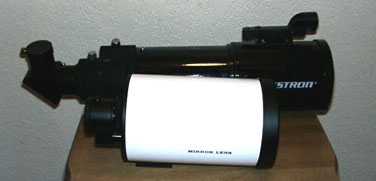 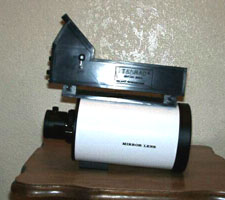
Physically, the scope is tiny - Just a bit bigger than the central section of the
ST-80's
body. Including the diagonal holder, it measures 8.75" long and
4.2" in diameter. (22cm x ~11cm) It is as long as a Telrad and
just a bit taller. |
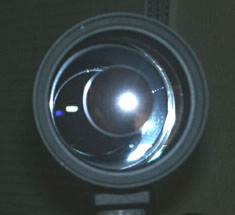
Note the large secondary.
|
The secondary is rather large (40mm of the 90mm objective), to ensure
that the image fills a prime focus 35mm film frame. That makes it
ideal for film photography, but it seems to reduce contrast and light gathering a
bit. Again, this is a reminder that this scope is marketed as a camera lens or spotting scope, rather than a
telescope. In fact, the tube is marked "mirrored lens". |
The coatings on the corrector plate show as a faint purple-green tint in reflections,
which change with the viewing and light angle. The mirror
coatings look even and bright. Collimation was good, though one
inexpensive
diagonal causes very poor collimation. This diagonal did not cause
problems with my short tube refractors.
The scope is well made and has a very solid feel. The fit and finish is
great overall and the various parts fit together tight and square.
There are two minor exceptions - The metal lens cover
is loose and falls off easily, but this is easily remedied with a bit of
felt. There is a minor run in the white paint. |
The rear cell is a bit crowded, but workable. The focuser is a small knob sticking out of the rear
cell and is clearly marked with a double arrow telling you which way to
focus for near or infinity. Focusing movement is a bit stiff and
can have some "rebound" in the cold.
The rear threads are smaller than Meade and Celestron SCT threads, so
normal SCT accessories won't fit. The diagonal holder has standard T-threads on it.
|
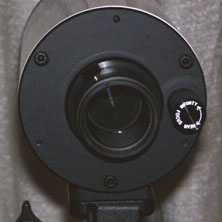
Note the handy label on the
focuser knob showing the
directions for near and far focus.
|
Finding rings for the scope may be a problem because it's just a bit too
big to fit the standard 4.1" rings and much too small for the next size
up at 4.6". You could pad the 4.6" rings or use 4.6" three point rings
like those from Scopestuff.com. Another complication is the placement of the tripod block - It sits less than 1/2" from the rear cell, leaving only 4" between the front of the block and rear of the lens cover. |
|
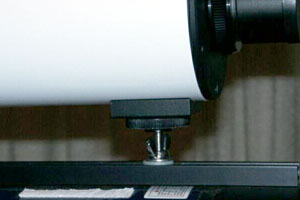
I have also
used Orion's
ball head camera mount set on the rails with a standard 1/4-20 bolt
and star washer. (Just pull up and spin the unit to tighten the screw
to the rail.) This mounting is stable enough for high magnification
work and allows you to align the scope with the larger goto scope so it
can perform as a super finder.
|
This scope is light enough to mount on a good camera tripod or with a
standard camera mount on another scope. I have scopestuff.com's
rails and the little scope works well on his camera mount works well for
low and medium power work.
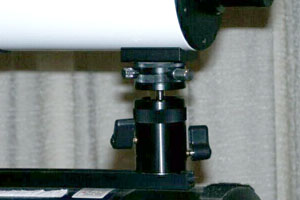
|
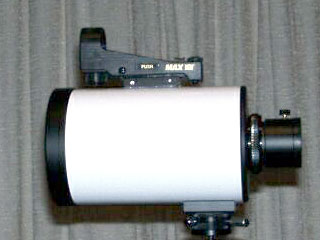
Daisy's MaxView sight makes a great finder and it's tall enough to stick
up over smaller eyepieces. |
The MC-90 comes without a finder, but that wasn't really a hindrance,
given the wide FOV and clean top of the scope. For the first few
session, sighting down the top of the scope was good enough find the
brighter winter objects with the 26mm Plossl. A small BB gun
red-dot sight would work wonderfully on this small scope, but you'll
need to remove taller eyepieces to see the red dot. I chose to
install the MaxView finder from Daisy, which seems to be a shorter
version of Apogee's Giant Mars-Eye finder.
|
If you're interested in this finder, here are two links for it:
MaxView, ($14 from K-Mart) http://daisy.ifware.com/cgi-bin/daisy2/products_maxspeed.html
Apogee's version (bottom of the page, $21.95, red & green dots,
higher mount):
http://www.apogeeinc.com/scopes.html |
After a few sessions comparing the new scope and my (Celestron) ST80 and
(Sky-Watcher) ST102 under suburban skies. I'm most impressed with the
views this compact scope provides. The ST80 and MC90 have roughly the same light gathering and contrast. The ST102 is very
noticeably better in both light gathering and contrast than either of the smaller scopes. Not surprisingly, the MC90 at f/5.6
provides comparable FOV to
the ST-80 & ST102 at f/5. A 25mm Plossl provides a view that
encompasses all of Orion's belt or swallows the Pleiades en masse.
A 10mm Plossl is just a bit larger than the full moon.
Excluding the secondary shroud and focusing tube, this scope has no
baffles and no dew shield. This means you can see off-axis light
perhaps 10 degrees from the full moon. A dew shield helps
somewhat, but the off-axis light does not seem to degrade the view of
the moon. Just don't try dim objects near the moon and this won't
be much of a factor. The interior of the tube appears to be a nice
flat black.
Another minor problem is images reflected between the field lens of
the eyepiece and the secondary mirror creates a bit of odd color at the
top and bottom of bright planets. Using the Omcon 25mm Plossl I
purchased with the scope, I had a startling image with the full
unfiltered moon. Without the diagonal, this eyepiece shows the
moon filling perhaps 1/4 of view and a ghostly pale blue image of the
moon - in focus! - that fills perhaps 3/4 of the view. Other
25-26mm Plossl eyepieces show similar images, but are not in
focus. When the diagonal is added to the mix, this reflected image
is spread out enough that only bright objects show any color. For
example, Jupiter shows a blue tint at top and a brown tint at bottom of
the view. This might blur the details at the poles, but is easy to
ignore. Besides, this is a rich field scope - Use it at low
magnification to get the most out of it!
|
I'll try to give my impressions & comparisons of the little
scope in suburban skies with good to very good seeing.
Quarter Moon - The views of the Moon at all magnifications
were crisp, clear, and nearly free of color. (The limb was tinted
very lightly blue.) With a 26mm Meade Plossl,
the dark side of the moon was visible, but no features came
through. The lit side was very sharp and impressive, with some
field stars visible. With my 4.8mm Nagler (roughly 100x), the view
was tack sharp and very clear. The FOV was slightly larger than
the moon itself. With the 4.8mm and a Barlow, the view
softened, but it was still very viewable. You won't count craterlets in Plato, but you will get
very nice general views of the moon.
Jupiter - With a 10mm Plossl, the equatorial bands were very visible, as were the four moons.
Additional details were visible during moments of good seeing.
I noticed some odd color in the bright planet as it neared the edge of the view.
(see above notes) It was not enough to distract from the
crisp view. I have had some viewing with my 4.8mm Nagler, which
provided excellent views on exceptional nights, but it is not an
everyday combination.
Saturn - Again, the 10mm Plossl was upper limit, but the view
was nice and clear. Some detail in the rings was visible during
clear moments of seeing.
Orion's Nebula - The view was nice, but not fantastic.
The light polluted skies (roughly mag 4.5) washed out the nebula.
The MC90 and ST80 had similar views, while the ST102 showed much more
detail. All three scopes showed improved views with a broad band
nebula filter. At higher magnifications, the Trapezium was visible, but
more details were not visible in the nebula as magnification increased.
Pleiades - With a 26mm Plossl, the view of this wonderful
cluster is breath-taking and easily encompasses the whole cluster,
including the little trail of stars off to one side. Even at that
wide view, the little triangle of stars next to Alcyone was
visible. (The dimmest star of the triangle is magnitude 8.65.) A
quick count of cluster stars showed roughly 50 stars easily spotted and
many dimmer stars were barely visible. I would expect those counts
to increase quite a bit at a dark site.
Bright Objects - The MC90 showed a faint rim of color on bright
objects, while the ST80 and ST102 showed large purple halos on Jupiter
and the Moon that greatly interfered with the view.
Bottom line? The MC90 matches the performance of the ST80
in rich-field views and does it in a smaller package. It also easily out-performs either short
tube refractor on bright objects. It At $220 US, this compact, care-free scope is
a great alternative to the ST80. I only wish that they offered
several sizes - I'd
love a 102 or 127mm version! |
|